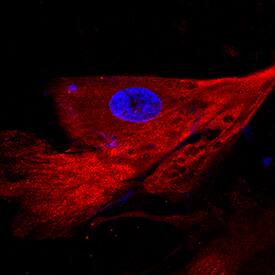Human C-Reactive Protein/CRP Antibody
R&D Systems, part of Bio-Techne | Catalog # AF1707


Key Product Details
Species Reactivity
Validated:
Cited:
Applications
Validated:
Cited:
Label
Antibody Source
Product Specifications
Immunogen
Phe17-Pro224
Accession # P02741
Specificity
Clonality
Host
Isotype
Scientific Data Images for Human C-Reactive Protein/CRP Antibody
Detection of Human C‑Reactive Protein/CRP by Western Blot.
Western blot shows lysates of human kidney tissue . PVDF membrane was probed with 0.5 µg/mL of Sheep Anti-Human C-Reactive Protein/CRP Antigen Affinity-purified Polyclonal Antibody (Catalog # AF1707) followed by HRP-conjugated Anti-Sheep IgG Secondary Antibody (HAF016). A specific band was detected for C-Reactive Protein/CRP at approximately 25 kDa (as indicated). This experiment was conducted under reducing conditions and using Immunoblot Buffer Group 1.C-Reactive Protein/CRP in Human Kidney Cancer Tissue.
C-Reactive Protein/CRP was detected in immersion fixed paraffin-embedded sections of human kidney cancer tissue using 1.7 µg/mL Human C-Reactive Protein/CRP Antigen Affinity-purified Polyclonal Antibody (Catalog # AF1707) overnight at 4 °C. Tissue was stained with the Anti-Sheep HRP-DAB Cell & Tissue Staining Kit (brown; CTS019) and counterstained with hematoxylin (blue). Specific labeling was localized to epithelial cells in tubules. View our protocol for Chromogenic IHC Staining of Paraffin-embedded Tissue Sections.C‑Reactive Protein/CRP in BG01V Human Embryonic Stem Cells.
C-Reactive Protein/CRP was detected in immersion fixed BG01V human embryonic stem cells differentiated into cardiomyocytes using Sheep Anti-Human C-Reactive Protein/CRP Antigen Affinity-purified Polyclonal Antibody (Catalog # AF1707) at 10 µg/mL for 3 hours at room temperature. Cells were stained using the NorthernLights™ 557-conjugated Anti-Sheep IgG Secondary Antibody (red; NL010) and counterstained with DAPI (blue). Specific staining was localized to cytoplasm. View our protocol for Fluorescent ICC Staining of Stem Cells on Coverslips.Applications for Human C-Reactive Protein/CRP Antibody
Immunocytochemistry
Sample: Immersion fixed BG01V human embryonic stem cells differentiated into cardiomyocytes
Immunohistochemistry
Sample: Immersion fixed paraffin-embedded sections of human kidney cancer tissue
Simple Western
Sample: Human Plasma, Human Liver
Western Blot
Sample: Human kidney tissue
Reviewed Applications
Read 1 review rated 5 using AF1707 in the following applications:
Formulation, Preparation, and Storage
Purification
Reconstitution
Formulation
Shipping
Stability & Storage
- 12 months from date of receipt, -20 to -70 °C as supplied.
- 1 month, 2 to 8 °C under sterile conditions after reconstitution.
- 6 months, -20 to -70 °C under sterile conditions after reconstitution.
Background: C-Reactive Protein/CRP
CRP is a member of the pentraxin family of proteins that are characterized by a cyclic pentameric structure. Human CRP gene encodes a 224 amino acids precursor. The mature human CRP protein has 206 amino acids that are non-covalently linked to form the pentameter. Human CRP shares 71% and 64% amino acid sequence homology with mouse and rat respectively.
CRP, synthesized by hepatocytes, is a major acute phase serum protein in human. IL-6, IL-1 and glucocorticoids are the major inducer of the CRP gene. In response to infection, inflammation or tissue damage, the level of CRP in human serum can increase 1,000-fold within 24‑48 hours. It will come back to base level of less than 1 μg/mL very fast. Human CRP is an acute-phase serum protein that plays a role in the first line in host innate host defense. Like other pentraxins, CRP exhibits Ca++ - dependent binding to ligands. Phosphocholine (PCh), a constituent of many bacterial and fungal walls, is a principal ligand of CRP. CRP also binds to the membrane of injured cells, membrane and nuclear components of necrotic and apoptotic cells. Upon binding with the ligands, CRP is recognized by C1q and initiates the activation of complement cascade. Ligand bound CRP also binds to Fc gamma RI and Fc gamma RIIa on phagocytes and activates phogocytotic responses. In addition to phogocytosis, CRP also can induce production of hydrogen peroxide and inflammatory cytokines, such as IL-1, IL-6 and TNF‑ alpha by monocytes. With these functions, human CRP is an important serum protein for anti-bacterial pathogen and clearance of damaged and apoptotic cells. However, in mouse, CRP is expressed at very low level and is not an acute phase reactant. Serum amyloid P component (SAP), another pentraxin, is the major acute phase serum protein in mice. It has been shown that high levels of CRP in humans is associated with an increased risk of cardiovascular diseases.
References
- Gotschlich, E.C. and G.M. Edelman (1965) Proc. Natl. Acad. Sci. USA 54:558.
- Volanakis, J.E. (2001) Molecular Immunology 38:189.
- Bharadwaj, D. et al. (1999) J. Experimental Medicine 190:585.
- Ballou S.P. and G. Lozanski (1992) Cytokine 4:361.
- Danesh, J. et al. (2004) N. Engl. J. Med. 350:1387.
Alternate Names
Gene Symbol
UniProt
Additional C-Reactive Protein/CRP Products
Product Documents for Human C-Reactive Protein/CRP Antibody
Product Specific Notices for Human C-Reactive Protein/CRP Antibody
For research use only


